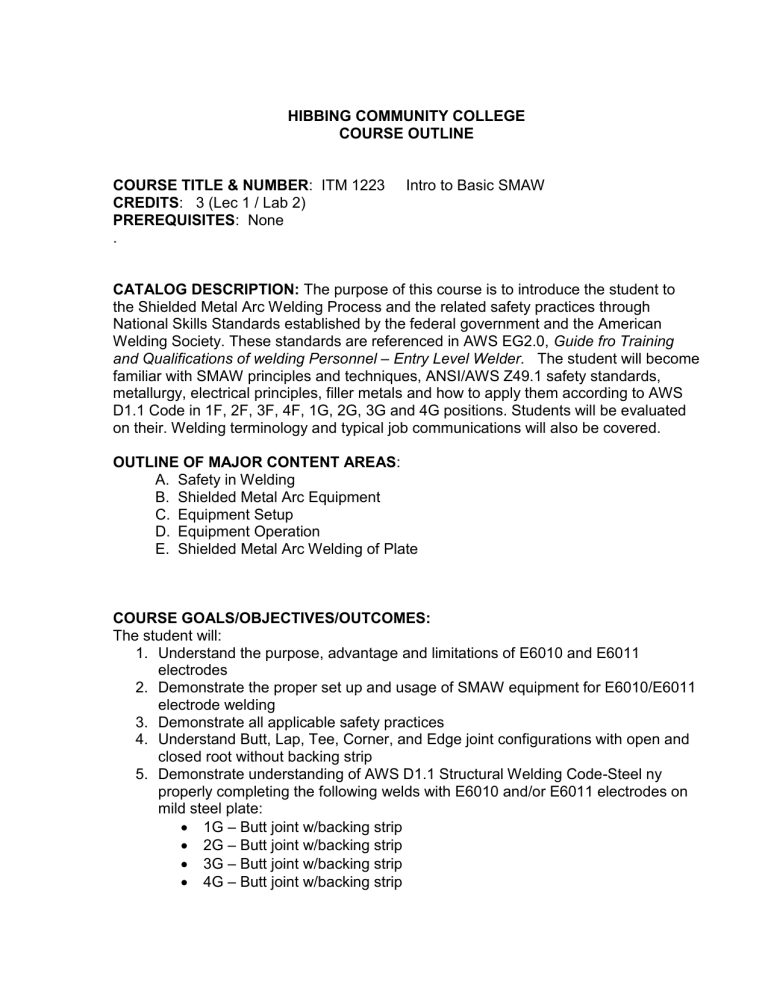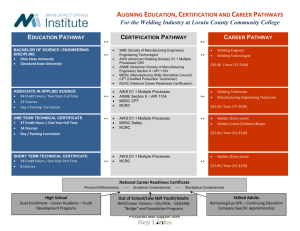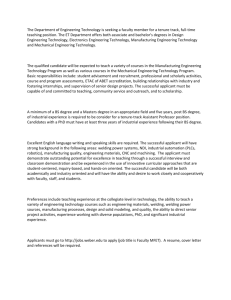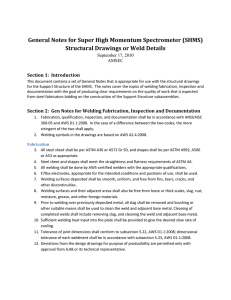HIBBING COMMUNITY COLLEGE

HIBBING COMMUNITY COLLEGE
COURSE OUTLINE
COURSE TITLE & NUMBER : ITM 1223 Intro to Basic SMAW
CREDITS : 3 (Lec 1 / Lab 2)
PREREQUISITES : None
.
CATALOG DESCRIPTION: The purpose of this course is to introduce the student to the Shielded Metal Arc Welding Process and the related safety practices through
National Skills Standards established by the federal government and the American
Welding Society. These standards are referenced in AWS EG2.0, Guide fro Training and Qualifications of welding Personnel – Entry Level Welder. The student will become familiar with SMAW principles and techniques, ANSI/AWS Z49.1 safety standards, metallurgy, electrical principles, filler metals and how to apply them according to AWS
D1.1 Code in 1F, 2F, 3F, 4F, 1G, 2G, 3G and 4G positions. Students will be evaluated on their. Welding terminology and typical job communications will also be covered.
OUTLINE OF MAJOR CONTENT AREAS :
A. Safety in Welding
B. Shielded Metal Arc Equipment
C. Equipment Setup
D. Equipment Operation
E. Shielded Metal Arc Welding of Plate
COURSE GOALS/OBJECTIVES/OUTCOMES:
The student will:
1. Understand the purpose, advantage and limitations of E6010 and E6011 electrodes
2. Demonstrate the proper set up and usage of SMAW equipment for E6010/E6011 electrode welding
3. Demonstrate all applicable safety practices
4. Understand Butt, Lap, Tee, Corner, and Edge joint configurations with open and closed root without backing strip
5. Demonstrate understanding of AWS D1.1 Structural Welding Code-Steel ny properly completing the following welds with E6010 and/or E6011 electrodes on mild steel plate:
1G – Butt joint w/backing strip
2G – Butt joint w/backing strip
3G – Butt joint w/backing strip
4G – Butt joint w/backing strip
1F – Lap, Tee & outside corner
2F – Lap, Tee & outside corner
3F
– Lap, Tee & outside corner
4F
– Lap, Tee & outside corner
(All welds are to be VT by instructor according to AWS D1.1, Table 6.1)
6. Demonstrate proper rod manipulation techniques
7. Demonstrate single pass and multiple pass welding techniques
8. Exhibit safe housekeeping procedures in the lab
9. Exhibit professionalism
10. Identify filler metals by their AWS classifications
11. Identify base metals by elementary metallurgy (mild steel, cast iron, low alloy steels, aluminum, brass, copper, stainless steel)
12. Show understanding of base metals and filler metals by choosing the correct filler metal for certain basic applications
13. Demonstrate Ohm’s law and how it relates to the welding circuit
14. Demonstrate and describe a welding electrical circuit
15. List and explain the 4 basic types of welding power supplies
16. Demonstrate knowledge of welding accessories
17. Demonstrate knowledge of welding safety equipment and clothing
18. Demonstrate basic welding terminology
19. Demonstrate general understanding and knowledge of ANSI/AWS Z49.1-99 Part
1, Sections 1, 2, 3, 4, 5, 6, 7 & 9 and Part 2, Section11, through oral and written tests
20. Describe general weld joint configurations
21. Describe rod angles and rod manipulation techniques
22. Explain the Heat Affected Zone and accompanying characteristics
23. Be able to recognize problems with and make minor repairs to welding equipment
STUDENT CONTRIBUTIONS :
The student is expected to:
1. Attend all lab sessions
2. Participate in class activities
3. Participate in class discussions
4. Hand in assignments when due
5. Ask questions if they do not understand any part of the instructions or procedures
METHODS FOR EVALUTING STUDENT LEARNING:
Observation of practical skills; Visual Testing to AWS D1.1 Code; Destructive testing of completed welds.
HCC COMPETENCIES MET :
Work productively and cooperatively
Ability to work safely in any lab or shop setting
Communicate clearly and effectively
Ability to communicate through visual presentations
Think creatively and critically
Ability to identify and solve problems
Ability to apply mathematics application skills
SPECIAL MATERIALS AND COSTS :
AASC APPROVAL: May 16, 2007
REVIEW DATE: May 2012









